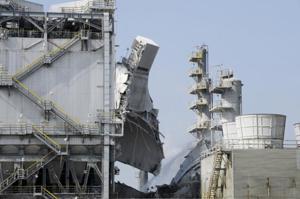US agency: Weak safety standards led to Exxon refinery blast
HOUSTON (Reuters) -- The US Chemical Safety Board (CSB) has concluded that a 2015 explosion at a Torrance, California, refinery then owned by ExxonMobil Corp could have been prevented, the agency concluded in a report issued on Wednesday.
"This explosion and near miss should not have happened," said CSB Chair Vanessa Allen Sutherland in a statement. "The CSB's report concludes the unit was operating without proper procedures."
The federal watchdog found that weaknesses in the Torrance refinery's safety program led to the blast.
The blast blew a large piece of debris 80 ft to nearby alkylation unit settler tanks containing toxic hydrofluoric acid, which the board called a "near-miss event."
Four workers suffered minor injuries and part of the refinery underwent a lengthy shutdown, contributing to a spike in the state's gasoline prices.
The Torrance refinery supplies 20% of the gasoline in Southern California and 10% statewide.
The explosion occurred when volatile hydrocarbons flowed backward through an idled gasoline-producing fluidic catalytic cracking unit (FCCU) to a pollution control device called an electrostatic precipitator (ESP), the CSB found.
The generation of sparks by the ESP ignited the hydrocarbons setting off the explosion.
The board, which has no regulatory authority and does not assess fines, found that the FCCU was operating without pre-established limits for a shutdown.
The agency also said Exxon relied on safeguards that it could not be sure were working and that a critical safeguard failed.
Exxon said in a statement: "We are confident we understand the cause of the blast and have worked cooperatively with the Chemical Safety Board and staff to fully understand their findings and recommendations."
Regarding the hydrofluoric acid, Exxon said, "There was no evidence the Feb. 18 incident posed any risk to the modified hydrofluoric acid alkylation unit or risk of harm to the community."
Residents near the refinery want local and state officials to ban the use of hydrofluoric acid in making octane-boosting gasoline additives.
Hydrofluoric acid is a highly toxic chemical that can kill or seriously injure at a concentration of 30 parts per million (ppm). As a gas it forms a ground-hugging cloud.
The board said it has asked a federal court to enforce subpoenas requiring Exxon to provide information about safeguards to prevent or mitigate a release of hydrofluoric acid.
Exxon said it "strongly disagrees" with any statement questioning its responsiveness or cooperation with the investigation.
"We offered to make additional documents available if the CSB could provide a sufficient basis for the documents and agreed to respect commercial confidentiality, which they have not done," a spokesman said Wednesday.
PBF Energy Inc, which acquired the refinery last year, "has already implemented a number of measures that address the CSB's recommendations," PBF spokesman Michael Karlovich said in a statement. "We plan to complete two studies later this year that will address the remaining recommendations."
The CSB determines root causes of chemical plant accidents and provides recommendations to companies, industry organizations and regulatory agencies.
Reporting by Erwin Seba and Liz Hampton in Houston; editing by Gary McWilliams and Matthew Lewis







Comments